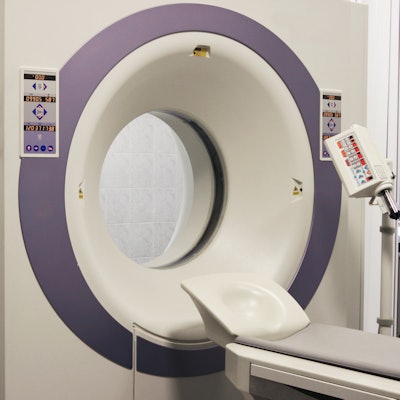
Areas of radiology that rely on CT stand to benefit the most from adjustments to the multiple procedure payment reduction (MPPR) of the professional component, according to research delivered at the recent American Roentgen Ray Society (ARRS) meeting in Washington, DC, and published in the April American Journal of Neuroradiology.
In 2012, the U.S. Centers for Medicare and Medicaid Services (CMS) implemented the MPPR, which resulted in a 25% cut to the professional component of reimbursement for imaging exams. However, last year, in part due to pressure from the American College of Radiology (ACR), it reduced the cut to 5%, said presenter Dr. Behnoud Baradaran Noveiry of Johns Hopkins University.
The agency's action is proving to be great news for CT-based areas, which were some of the hardest hit by the cut, and the change better reflects the reality of radiology practice.
"CMS justified the [25%] MPPR for the professional component with the rationale that radiologists don't perform some reporting activities twice within one report for multiple studies," he said. "But research has shown that the maximum estimated percentage work reduction when multiple services are performed by the same physician in the same session is small, ranging from 4.3% to 8.2% -- substantially less than the 25% professional component MPPR CMS originally set."
Rolling back the rollbacks
CMS first put the MPPR initiative into action in 2006, instituting a 25% reduction in technical component payments for advanced diagnostic imaging (CT and MRI) of contiguous body parts (head and neck, abdomen, and pelvis) performed on the same patient on the same day. In 2011, this reduction was expanded to 50%. A year later, CMS imposed a 25% cut on the professional component.
 Dr. Behnoud Baradaran Noveiry from Johns Hopkins University.
Dr. Behnoud Baradaran Noveiry from Johns Hopkins University.But in 2017, due to lobbying from the ACR, the American Medical Association (AMA), and the American Society of Neuroradiology (ASNR), CMS rolled back the MPPR percentage cut for the professional component from 25% to 5%. Some researchers have estimated that, going forward, the change will restore up to $64 million in Medicare reimbursement to radiologists each year.
To investigate the impact of this adjustment at Johns Hopkins, Noveiry and colleagues analyzed current procedural terminology (CPT) codes and reimbursement data for the procedures performed in the hospital's radiology department on Medicare beneficiaries between January and May 2017 (Am J Neuroradiol, April 2018, Vol. 39:4, pp. 612-617).
The researchers counted procedures with the highest price as fully reimbursed, while subsequent imaging was marked for further calculations, be it 25% reduction (2013 to 2016) or 5% reduction (2017). They sorted CPT codes into four different imaging categories: neuroradiology, body, musculoskeletal, and breast.
"Because our emergency department physicians often request imaging of multiple body parts for trauma and our oncologic practice uses chest, abdomen, and pelvic CT scanning to screen for and follow cancers, we hypothesized that we would see a large increase in revenue from the 2017 MPPR decision," Noveiry said.
The study included 8,787 patients with 22,236 applicable exams, which represented a mean of 2.5 studies per day. The researchers projected that five-month total reimbursement would be $1.7 million (at the 5% MPPR cut), an increase of 12.1% or $179,782, compared with the 2012 to 2016 time frame of 25%.
| Effect on imaging revenue of switch from 25% to 5% MPPR | ||
| Percent of studies subject to MPPR |
Revenue increase | |
| Imaging modality | ||
| CT | 61.2% | 12.1% ($128,542) |
| MRI | 54.9% | 11.6% ($47,802) |
| Ultrasound | 85.4% | 21.2% ($3,439) |
| Imaging category | ||
| Neuroradiology | 67.9% | 14.4% ($88,346) |
| Body imaging | 53.8% | 10.2% ($86,123) |
| Musculoskeletal | 71.7% | 16.6% ($5,172) |
| Breast | 53.3% | 12.3% ($141)* |
The MPPR adjustment evens out the radiological playing field, Noveiry told AuntMinnie.com via email.
"Following the new MPPR modification, the gap between different subspecialties has decreased, and this leads to improved self-sufficiency of different divisions of radiology practice," he said.
CT benefits
CT-heavy areas such as neuroradiology and body imaging have benefited the most from this favorable adjustment in the MPPR, Noveiry said. In fact, the neuroradiology service at Johns Hopkins has had the biggest increase in revenue, due to a high number and rate of MPPR-impacted exams, a high volume of both MR and CT studies, and high reimbursement for MR imaging compared to CT, he said.
"Although the overall rate of MPPR for neuroradiology was lower than for musculoskeletal studies [67.9% versus 71.7%], the higher volume of cases subject to MPPR favored the reimbursement of neuroradiology," Noveiry explained.
He cautioned, however, that even though 2017 brought some good news, radiologists should continue to pay attention to CMS' implementation of the MPPR.
"We need to monitor the MPPR regulation, and track how it is impacting our revenue and divisional self-sufficiency," he said. "As the MPPR is based on increased efficiency of multiple procedures in a single session, radiologists should also conduct more evidence-based studies to clarify just how extensive the increased efficiency really is, so reimbursement adjustment can be fairer."





















